The transformation of form—both figural and narrative—occurs as new universal truths arise and the experience of living changes. Antoine Louis Barye captures the essence of nineteenth-century Europe in his bronze predator and prey table-top sculpture groups through unifying the human and animal psyche. In Standing Lion and Serpent (ca. 1820-1825, Bronze, Mead Art Museum) (fig. 1), Lion Crushing a Serpent (ca. 1832, Bronze, Walters Art Gallery) (fig. 2), Lapith Combating a Centaur (Ca. 1840, Bronze, Smith College Art Museum) (fig. 3), and Theseus Slaying the Centaur Bienor (1849-1850, Bronze, Smith College Art Museum) (fig. 4) Barye uses animal and human bodies as his primary vessels for psychological evocation. How do extreme table-top scenes of combat represent a universal truth and capture the essence of the changing human experience of the nineteenth-century?
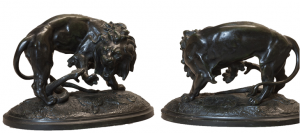
Barye, Antoine-Louis. Standing Lion and Serpent. Ca. 1820-1825. Bronze. Mead Art Museum,
Amherst College, Amherst.
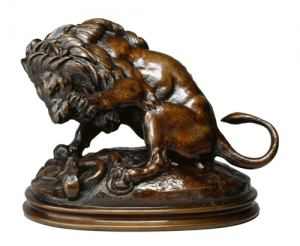
Barye, Antoine-Louis. Lion Crushing a Serpent. Ca. 1832. Bronze. The Walters Art Gallery,
Baltimore.
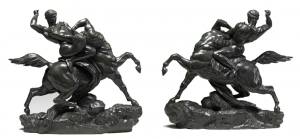
Barye, Antoine-Louis. Lapith Combating a Centaur. Ca. 1840. Bronze.Smith College Art
Museum, Northampton.
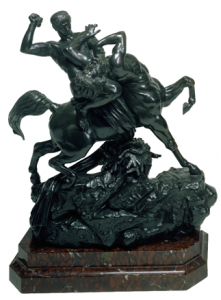
Barye, Antoine-Louis. Theseus Slaying the Centaur Bienor. Modeled 1849-1850. Bronze.
Smith College Art Museum, Northampton.
Scientifically and politically, nineteenth-century Europe was plagued with an overwhelming and startling new view and understanding of humankind and the world. Though often considered as such, art and science are not mutually exclusive. The convergence of science and art emerged in the nineteenth century as the culmination of scientific discoveries, political unrest, and a desire for new sculptural form began to reach an epicenter. The emerging popularity and awareness of new discoveries and theories involving Darwinian and Lamarkist evolution completely enthralled the science and arts communities. Artists were actively pursuing a way to add a new dimension to the implied linear narrative and formal qualities of sculpture, and they sought refuge in the new scientific discoveries which brought on a new cerebralized awareness of self. Emerging politics and scientific theories urgently prompted a new form of sculptural representation to reflect the changing human experience. Artists such as Charles Henri Joseph Cordier were experimenting with sculptural form by representing ‘evolutionary’ notions of ‘race’ to try and assimilate artful and ‘scientific’ representations of mankind. Other artists, such as Honoré Daumier, were using political commentary to experiment with figural representation. Antoine-Louis Barye, originally a goldsmith, combined ideologies of craftsmanship, science, and the Beaux-Arts aesthetic for his sculptural compositions. Barye’s artistic agenda parallels with the nineteenth century’s search for new sculptural form in that they both involve intricate variables. Barye’s focus on the hybridization of craftsmanship and anatomically accurate detail creates a scientific lens for the construction of his compositions. Barye’s formal training in art from antiquity, the Renaissance, and Mannerism generates evocative complexity in his compositions rooted in formal elements such as figural composition, spatial dynamics, and subject matter. Barye’s multi-faceted artistic ideologies coincide with the call to new sculptural form because both heavily rely on the amalgamation of art and science.
Barye established a symbiotic relationship between art and science ideologically and compositionally. The intellectual, ideological, and compositional levels of his predator and prey sculpture groups created a dichotomy of new form that exists narratively and aesthetically. In these groups, Barye approached notions of the sublime by combining scientifically accurate animal depictions with emotionally charged compositions. Barye’s consilience of science and art in Standing Lion and Serpent (ca. 1820-1825, Bronze, Mead Art Museum) (fig. 1), Lion Crushing a Serpent (ca. 1832, Bronze, Walters Art Gallery) (fig. 2), Lapith Combating a Centaur (Ca. 1840, Bronze, Smith College Art Museum) (fig. 3), and Theseus Slaying the Centaur Bienor (1849-1850, Bronze, Smith College Art Museum) (fig. 4)creates a sculptural narrative rooted in an archetypal psychological experience between predator and prey. This experience introduces a non-linear sculptural narrative. Barye neither emphasizes the beginning nor the end of the conflict presented. The narrative of these groups is instead based on a fleeting psychological instant between the two combating figures. Barye uses his scientific approach to detail in these groups in order to depart from voyeuristic artistic choices that imply linear narrative in favor of strikingly realistic visual clues that convey extreme senses of emotion such as panic, rage, and pleasurable triumph. Because the figures in these groups are either animal or mythical, the presence of an altercation seems natural; however, the passionate evocation of the struggle itself drives the movement of the sculpture. Barye’s scientific representation of body composition regarding muscular definition and spatial dominance therefore is primarily responsible for creating a narrative that exists outside of time, and is instead rooted in a psychologically evocative struggle [1].
The creation of a psychological narrative lies in the subtleties behind his advanced education in goldsmithery, art, and science. Barye’s well-rounded education reveals that the intention behind his choices regarding these predator and prey groups is far more deep seated than mere aesthetic or representation, “…the range and character of the sources of Barye’s art [was] nature itself, the art of recent goldsmithery, and the sculpture of antiquity” (Benge, 16). Barye was effectively commenting on the changing world surrounding him by incorporating and interpreting new scientific discoveries through his art. The union of Barye’s experience with craftsmanship, formal artistic training, and understandings of science began early in his life. His youngest years were primarily rooted in goldsmithery, “Barye saw the most sophisticated technical practices among Partisan Goldsmiths;” however, he also “encountered Neoclassical and antique models that would remain significant through his career” (Fusco, 124). Barye’s formal education of art was a sophisticated accumulation formed by his early years as a craftsman.
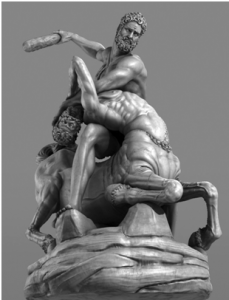
Giambologna. Hercules Fighting with the Centaur Nessus. 1599. Marble. Loggia della Signoria,
Florence.
The dichotomy of Barye’s repertoire is present in Theseus Slaying the Centaur (fig. 4)and Lapith Combating a Centaur (fig. 3)because of their ties with the renaissance sculpture Hercules Fighting with the Centaur Nessus (fig. 5) by Giambologna in 1599. Compositionally, the figures are all arranged the same way: the (assumed) protagonist is positioned atop the centaur’s back with his armed raised, with the centaur struggling to release himself from the protagonist’s grip (fig. 6). Barye continues the similarities in his treatment of Theseus’ and Lapith’s face: they both are allusions to antiquity which is directly parallel to Hercules’ face (fig. 7). Barye’s nod to antiquity can specifically be seen in the treatment of Theseus’/Lapith’s hair. Barye specifically strays from Giambologna’s form in his composition of the centaurs’ bodies (fig 8). Where Giambologna creates the image of the distinctive mythical centaur with tufts of fur separating the human and animal segments of the body, Barye opts for a smooth transition between the horse bottom and the human torso. This illustrates Barye’s intentional departure from traditional form he learned in the Académie des Beaux-Art, in favor of a visual assimilation between human and animal, which he was able to successfully accomplish through his training as a craftsman and his in depth-study of animal form. This visual assimilation of human and animal form creates a subconscious union of the human and animal psyche, a union that is indeed expressed through mutual significance of stressed muscles both in the horse’s portion of the body and the man’s portion of the body. This transition will serve as a pretext for understanding the parallels in psychological states and body composition.
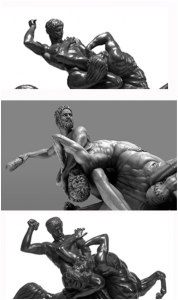
Top: Theseus Slaying the Centaur Bienor.
Center: Hercules Fighting with the Centaur Nessus
Bottom: Lapith Combating a Centaur

Left: Theseus Slaying the Centaur Bienor
Center: Hercules Fighting with the Centaur Nessus
Right: Lapith Combating a Centaur
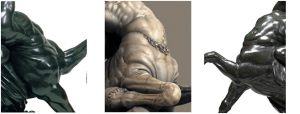
Left: Theseus Slaying the Centaur Bienor
Center: Hercules Fighting with the Centaur Nessus
Bottom: Lapith Combating a Centaur
Barye’s education in science was largely self-taught, “He studied living animals in the menagerie of the Jardin des Plantes and studied specimens and skeletons at Musee d’ Anatomie Comparee…Notations in his sketchbook show he observed dissections and read recent scholarly papers on species he depicted” (Fusco, 124). Barye’s self-imposed scientific learning further contributes to his intentional combination of art and scientific representation in Standing Lion and Serpent, Lion Crushing a Serpent, Lapith Combating a Centaur, and Theseus Slaying the Centaur, “Even the most Romantic, realistic bronzes of Animals of his later career reflect his thorough assimilation of classical prototypes” (Fusco, 124). The intention behind the scientific realism of these sculptures shows educated reasoning to juxtapose strikingly accurate anatomical detail with severely charged psychological representations. Jacques de Casto’s article, “The Origin of Barye’s Ape Riding a Gnu,” provides some insight to the drive behind Barye’s scientific inquiries. De Casto explains that when creating his works, Barye would use “unusual painstaking methods of measuring each part of the body in order to master the anatomy of the animal” (71). An early work, Ape Riding a Gnu (ca. 1840, Bronze, Walters Art Gallery)provides some insight regarding Barye’s stance on evolution. Very literally, an ape riding a gnu signals intention and brain activity on par with that of a human, showing Barye’s “belief in the intelligence of primates,” therefore opening the psychological bridge between human beings and animals (de Casto, 68). Barye’s intricate methods in construction display a distinct focus on accurate detail and representation; he sought not to merely represent an animal form, but rather to capture the essence of the animal’s behavior and psyche while bringing that essence into a human context. Barye also opts for malapropos parings between his predator and prey sculpture groups: lions and serpents, jaguars and hares, and apes and gnus rarely interact. Removing geographical boundaries and landscape markers in his sculptures further speaks to Barye’s ideologies surrounding the truth about the psyche and emotion. So, Barye further emphasizes his new form by removing the divide between humans and animals—and arguably between humans and humans—showing that there are staunch emotional ties between all, creating a visual representation of the universal truth of psychology.
As we have already discussed, Barye’s scientific approach to the composition of his figures, specifically that of the transition between the centaurs’ human and horse bodies in Theseus Slaying the Centaur and Lapith Combating a Centaur allows for the assimilation between human and animal psyche through body composition. Barye’s staunch attention to detail in regards to animals’ muscular definition is the primary evocative element in indulging in the psyche. Barye’s, Standing Lion and Serpent (fig. 2)and Lion Crushing a Serpent (fig. 1) is the epitome of the predator and prey group: two deadly lifeforms locked in battle. Though the Mead Art Museum’s Standing Lion and Serpent is not the exact cast as the Walters Art Gallery’s Lion Crushing a Serpent, the larger psychological implications can be noted in both works via the similarities and differences. The compositional difference in the figures is largely based on the serpent. Standing Lion and Serpent presents the serpent predominantly in three dimensions, the base of the body and the tail is a high relief extension of the surrounding landscape (fig. 9). The serpent’s mid-body is coiled under the hindquarters of the lion, his tail winding to the left (or back) side of the landscape of the bronze. The serpent’s head is extended off the ground, lunging towards the lion. Similarly—though perhaps more discrete—Lion Crushing a Serpent presents the serpent about to strike, however, the serpent’s entire body is a high relief blended with the landscape platform (fig. 10). The serpent’s head, only slightly projecting from the base, is recoiled, marking his aim for a strike. The entire figure of the serpent in this sculpture resides in the base. The serpent, too, is also predominantly looping under the lion’s front half, with its tail extending in curvature through the length of the lion’s underbelly. The lion, though largely in the same figural composition as in Standing Lion and Serpent is turned the other way, extending the left paw, as opposed to the right, and is squatting his hindquarters to the ground. Though compositional differences exist, the muscular definition of the two compositions remains fluid. Barye places equal significance on the tensions in the body, showing that the emotion on both sides of the struggle is equally important.
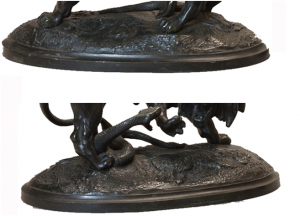
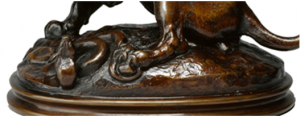
The unimportance of setting and geographic landscape representation in all four of the bronzes that we have discussed further stresses the irrelevance of time unfolding in Barye’s predator and prey groups. Theseus Slaying the Centaur and Lapith Combating a Centaur have virtually the same scene, however the geographic setting changes. Though the landscape is different, the composition and the action poses are the same. Theseus is much more detailed surface-wise; however, neither sculpture shows a sacrifice in the detail reflecting the muscular definition. Because the muscular definition is the same, but the setting and the title changes, one can infer that the implied narrative is not supposed to be as generous to the viewer’s imaginative experience as the detail in the figural composition and surface texture, specifically regarding the muscular make up. The geography and settings in the bronzes are inconsistent. The facial expressions are different; so are the horses’ tales (fig. 5, 11). Despite these differences, which seem extreme because they are the most objectively expressive part of the human and of the horse, the muscular composition of both sculptures remains the same. This is extremely important when realizing the emphasis Barye places in scientific accuracy when it comes to figural composition in both human and animal sculptures. Though the landscape, title (and therefore implied narrative) and direct expressive attributes vary between the two extremely similar sculptures, the muscles and their emphasis remain the same and remain in the forefront, this shows that Barye sees the body, both in human and animals as the primary expressive vessel for psychological states. It has already been established that Barye stressed scientific representation in form, which means his choice in a non-descript setting and landscape was an intentional escape from any traditional narrative presumptions. Barye’s choices in setting are even less noticeable in Standing Lion and Serpent (fig. 2)and Lion Crushing a Serpent (fig. 1). Again, the landscapes change in both figures; however, in this group, the landscape is even less present to begin with. Lion Crushing a Serpent features a texturized ground with small details of rock blended in low-relief on the ground, along with the serpent (fig. 10). In Standing Lion and Serpent, the ground, again is texturized, however, this time, there are low-relief details of plant life (fig. 9). Virtually the same anatomical accuracy, however, the landscape changes, suggesting that the altercation is independent of circumstance and perhaps entirely unavoidable, thus contributing to the archetypal stand-off between predator and prey.
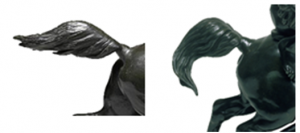
Left: Lapith Combating a Centaur
Right: Theseus Slaying the Centaur Bienor
Another essential element of Barye’s form to take into account is the size of his popular works. He preferred to work in table-top bronzes. The copious amount of detail that Barye incorporated into these small-sized works indicates that he intended them to be much more than decorative objects; and they were. The detail in muscular definition, facial form, and spatial dominance in both his human and animal works demands extensive attentive looking; designed to be slowly taken in and thought about by the viewer, the small size of the works made the detail ever-more evocative. The resonating psychology that transpires within these works, which becomes dominantly present though Barye’s scientific detail, allowed Barye to “divorce the image [of the small prototype]’s role as a mere embellishment on a useful object and elevated it to the qualitative and conceptual level of a free, major art form” (Benge, 17). The veristic accuracy with animal anatomy leads to a relationship with physical manifestations of emotion. These manifestations were both intriguing and evocative, which, in turn, removed the necessity for a linear narrative. The sculpture did not require a point in time: the essences of the works were not dependent on events unfolding but rather functioned to reveal a universal truth about the psyche. Thus, these works lead to a new fine art form: small sized sculpture and psychologically–driven narratives.
Each and every one of the sculptures, Standing Lion and Serpent, Lion Crushing a Serpent, Lapith Combating a Centaur, and Theseus Slaying the Centaur Bienor, presents a potential stalemate between the predators. The muscles and the landscape play into the creation of a psychological narrative; however, the role of spatial relations in the figural compositions also have important implications. Though one sculpture is more direct about the outcome of the narrative (Lion Crushing a Serpent), both sculptures’ distinguished realistic stances mark a fleeting moment, not in battle, but of kill or be killed, predator or prey. This instance is so defined in the anatomy because it marks the moment where each opponent makes the choice to act as either predator or prey. Perhaps, the reason for the differences in sculpture is because Standing Lion and Serpent was made before Lion Crushing a Serpent. Lion Crushing a Serpent was made for the royal house of Orleans and the differences in figural composition and its addition to implied narrative were no doubt intended to convey a political implication (Fusco 124).
Deeper consideration of the politics of France in the mid-nineteenth century is essential when answering the question, “Why did Barye use animals to represent human psychological states?” Barye was pushed into the spotlight, and consequently, the government’s eye in 1831 where he received critical acclaim for Tiger Devouring a Gavial of the Ganges (Fusco 124). His budding reputation lead him to a swift commission from the Royal House of Orleans (Fusco 124). After this, he was commissioned by the Duc d’Orleans to do a set of table-top bronze animal sculptures. He also made The Lion and the Serpent for the House of Orleans which he showed in the Salon of 1833 along with a plaster bust of the Duc d’Orleans. After the Salon the bronze was then purchased by the Senate in 1834. At this point Barye was on the July Monarchy’s payroll, thus causing a need for more subtlety when expressing the experience of the French in his artwork. The use of animals functioned for several reasons: they were archetypal symbols (i.e. the lion, the serpent, the hare), they played into scientific topics of the time, and they removed the need for a linear narrative. Most importantly, however, the use of animals allowed safe representation of turmoil and unrest that both viewer and audience could express without directly naming a person, a group, or a specific event—the animal forms allows pure the psychology of the work to take over. Barye’s departure from veristic representations of people, allowed him to create evocative works without putting his career in jeopardy. Perhaps, the reason for the differences in the sculptures, Standing Lion and Serpent and Lion Crushing a Serpent is because Standing Lion and Serpent was made before Lion Crushing a Serpent. Lion Crushing a Serpent was made for the royal house of Orleans and the differences in figural composition and its addition to implied narrative were no doubt intended to convey a political implication.
Antoine Louis Barye’s predator and prey groups represented the culmination of all the changing facts of the world in the nineteenth-century. These evocative portrayals exist within the figures’ psychological states, which are known through visual clues. These objective visual clues are created from Barye’s scientific approach to figural composition; paying specific attention to the muscular definition and anatomical accuracy of his figures. These visual clues serve to represent a universal truth independent of species, setting, and the narrative’s chronology. They are archetypal in that they represent unavoidable struggles and psychological stand-offs which can be present in any one person or animal’s life. Creating a psychological narrative form that specifically represents these struggles between predator and prey was increasingly important in the nineteenth century not only because of political upheaval but also social upheaval. With evolutionary science getting carried away and branching into studies of ‘race,’ the tensions between predator and prey seemed ever-more important to represent as multiple groups of people were other-ed through false pseudo-science. By essentially using popular scientific study and artistic representations against themselves in Standing Lion and Serpent, Lion Crushing a Serpent, Lapith Combating a Centaur, and Theseus Slaying the Centaur Bienor to create a psychological narrative that speaks to the tensions of the time, Barye was able to rise to critical acclaim while also accurately representing the psychological essence of the nineteenth century.
[1] Through looking at Barye’s art in conjunction with the work of canonical artists at the time that was similar in subject-matter, the grasp on what Barye was formally doing differently from other artists becomes clear. Glenn F. Benge’s article, “Barye’s Uses of Some Jean-Louis André Théodore Géricault Drawings,” specifically compares Barye’s studies of Géricault’s drawings of Boxers with the Géricault originals. Benge’s comparison reveals that, “Barye’s major alteration of Géricaultimages and its antique prototypes was his preference for a face-to-face combat” (27). This preference, then, is an indication of Barye’s intentional choice to display scenes with heightened emotion, specifically within a predator and prey dynamic.
Image List
Barye, Antoine-Louis. Lapith Combating a Centaur. Ca. 1840. Bronze.Smith College Art Museum, Northampton.
[Images Courtesy of the Smith College Art Museum]
Barye, Antoine-Louis. Lion Crushing a Serpent. Ca. 1832. Bronze. The Walters Art Gallery,
[Image Courtesy of Walters Art Gallery]
[Image of different cast of same sculpture courtesy of Christie’s Online Art Gallery: http://www.christies.com/lotfinder/LargeImage.aspx?image=http://www.christies.com/lotfinderimages/d40808/d4080896x.jpg]
Barye, Antoine-Louis. Standing Lion and Serpent. Ca. 1820-1825. Bronze. Mead Art Museum, Amherst College, Amherst.
[Images Courtesy of the Mead Art Museum]
Barye, Antoine-Louis. Theseus Slaying the Centaur Bienor. Modeled 1849-1850. Bronze. Smith College Art Museum, Northampton.
[Image Courtesy of the Smith College Art Museum]
Giambologna. Hercules Fighting with the Centaur Nessus. 1599. Marble. Loggia della Signoria,
[Image Courtesy of Wikipedia: http://upload.wikimedia.org/wikipedia/commons/9/90/Giambologna_herculesenesso.jpg]
[Image Courtesy of Digital-images.net: http://www.digital-images.net/Images/Florence/Sculpture/Hercules_Nessus_Loggia_deiLanzi_4125MG.jpg]
Works Cited
“Antoine-Louis Barye: Theseus Fighting the Centaur Bianor.” The Metropolitan Museum of Art: Collection Online. The Metropolitan Museum of Art, n.d. Web.
Ballu, Roger and Euge?ne Guillaume. L’œuvre De Barye. Paris: Maison Quantin, 1890. Print.
Benge, Glenn F. Antoine-louis Barye, Sculptor of Romantic Realism. University Park: Pennsylvania State University Press, 1984. Print.
Benge, Glenn F. “Barye’s Uses of Some Ge?ricault Drawings.” The Journal of the Walters Art Gallery. (1968): 13-27. Print.
Caso, Jacques de. “The Origin of Barye’s “ape Riding a Gnu”: Barye and Thomas Landseer.”TheJournal of the Walters Art Gallery. (1964): 66-73. Print.
Fusco, Peter, and H W. Janson. The Romantics to Rodin: French Nineteenth-Century Sculpture from North American Collections. Los Angeles, Calif: Los Angeles County Museum of Art, 1980. Print
